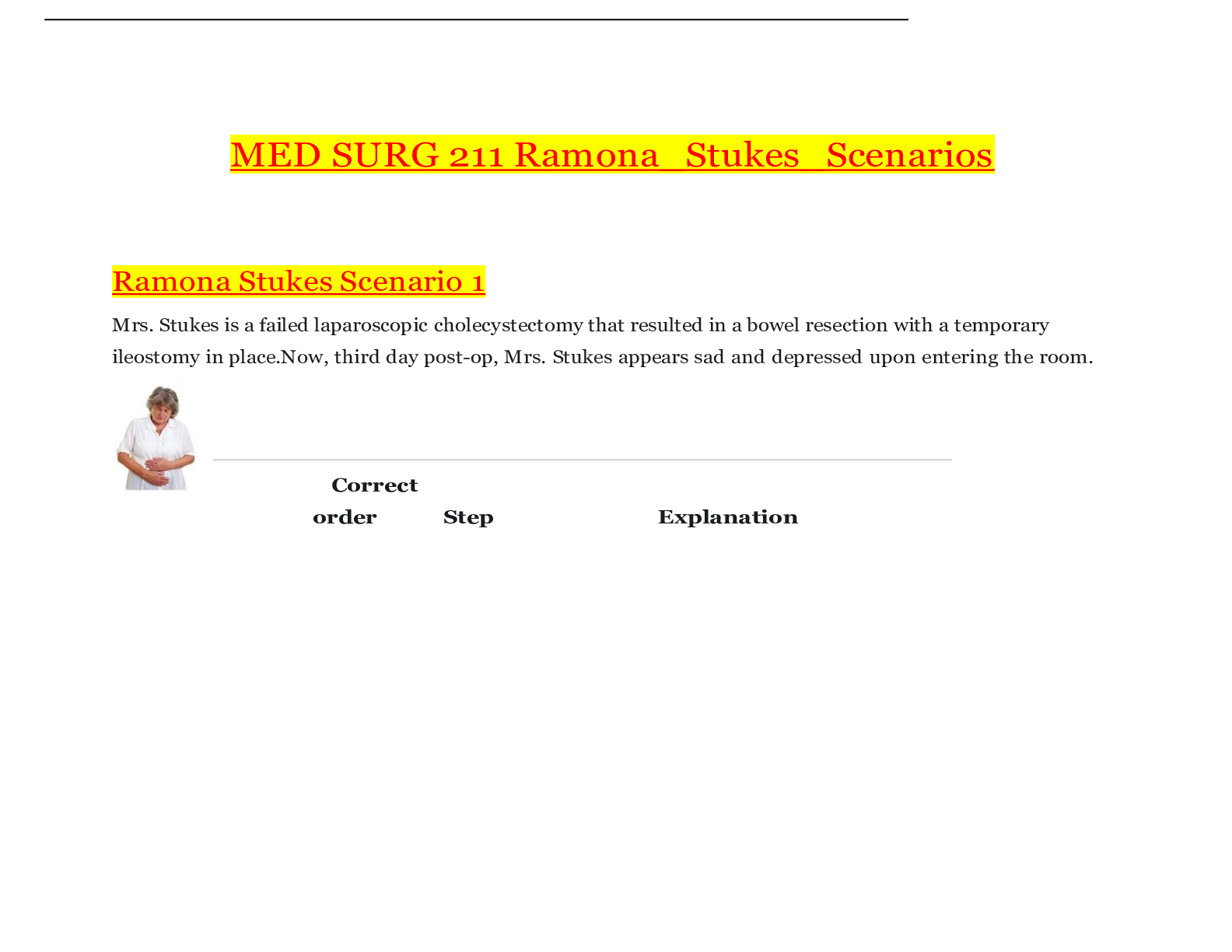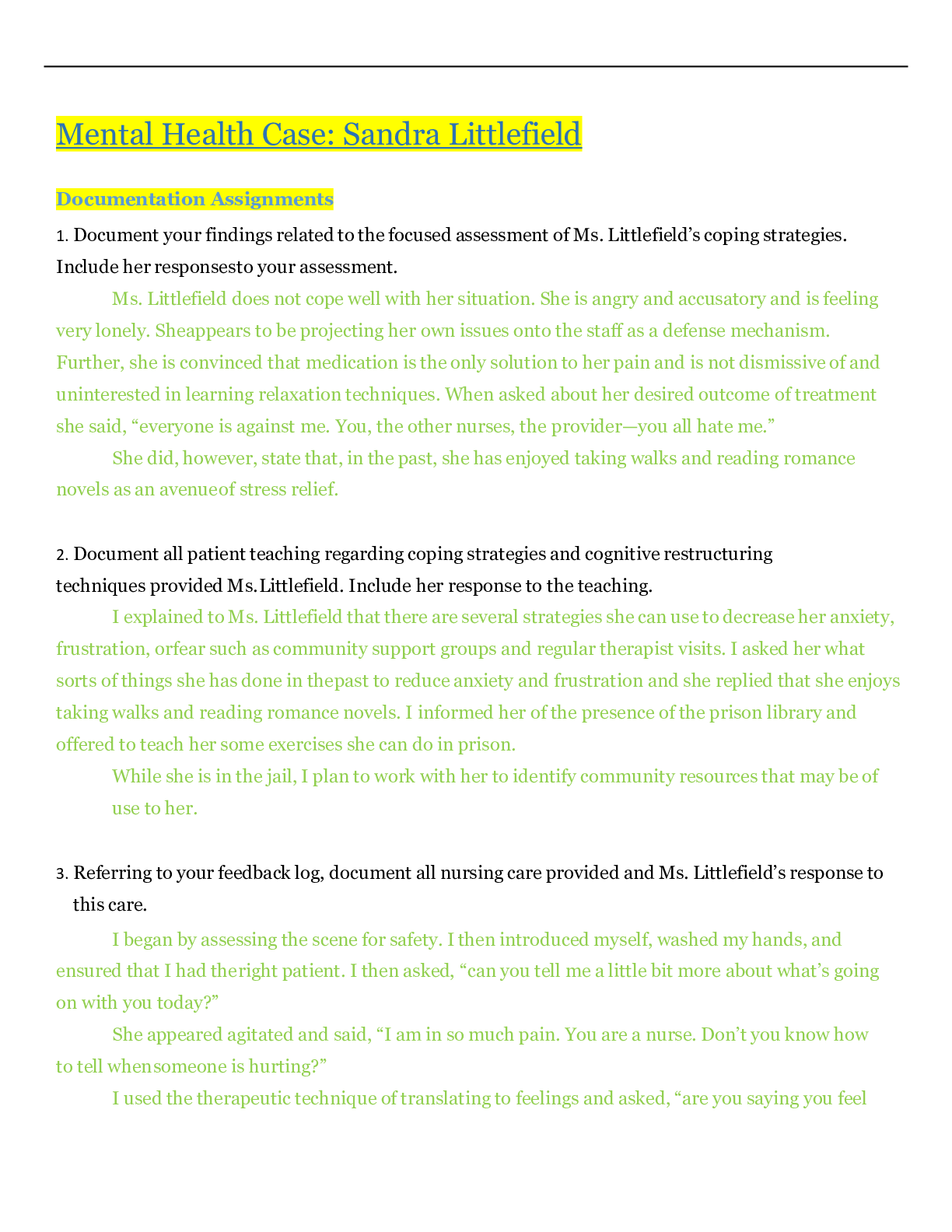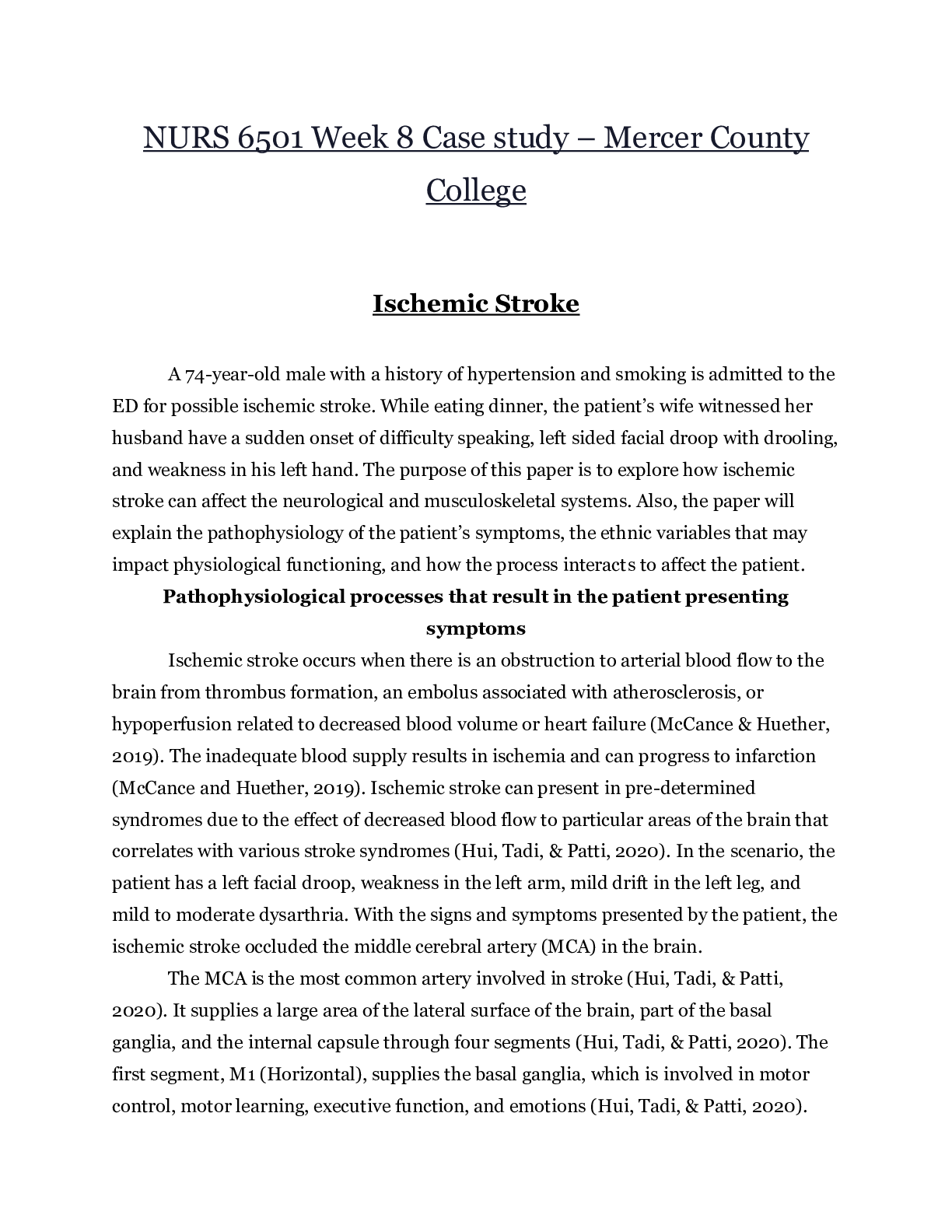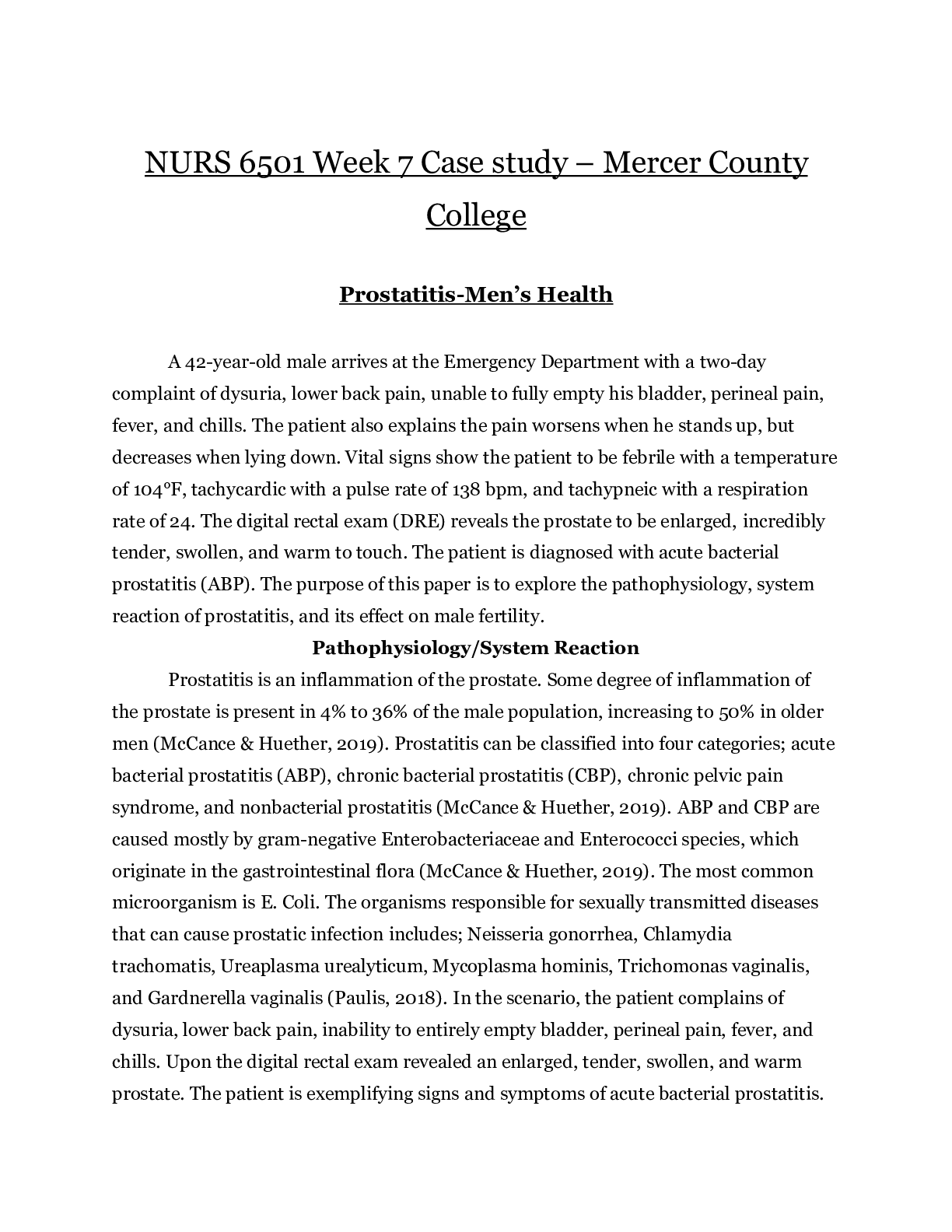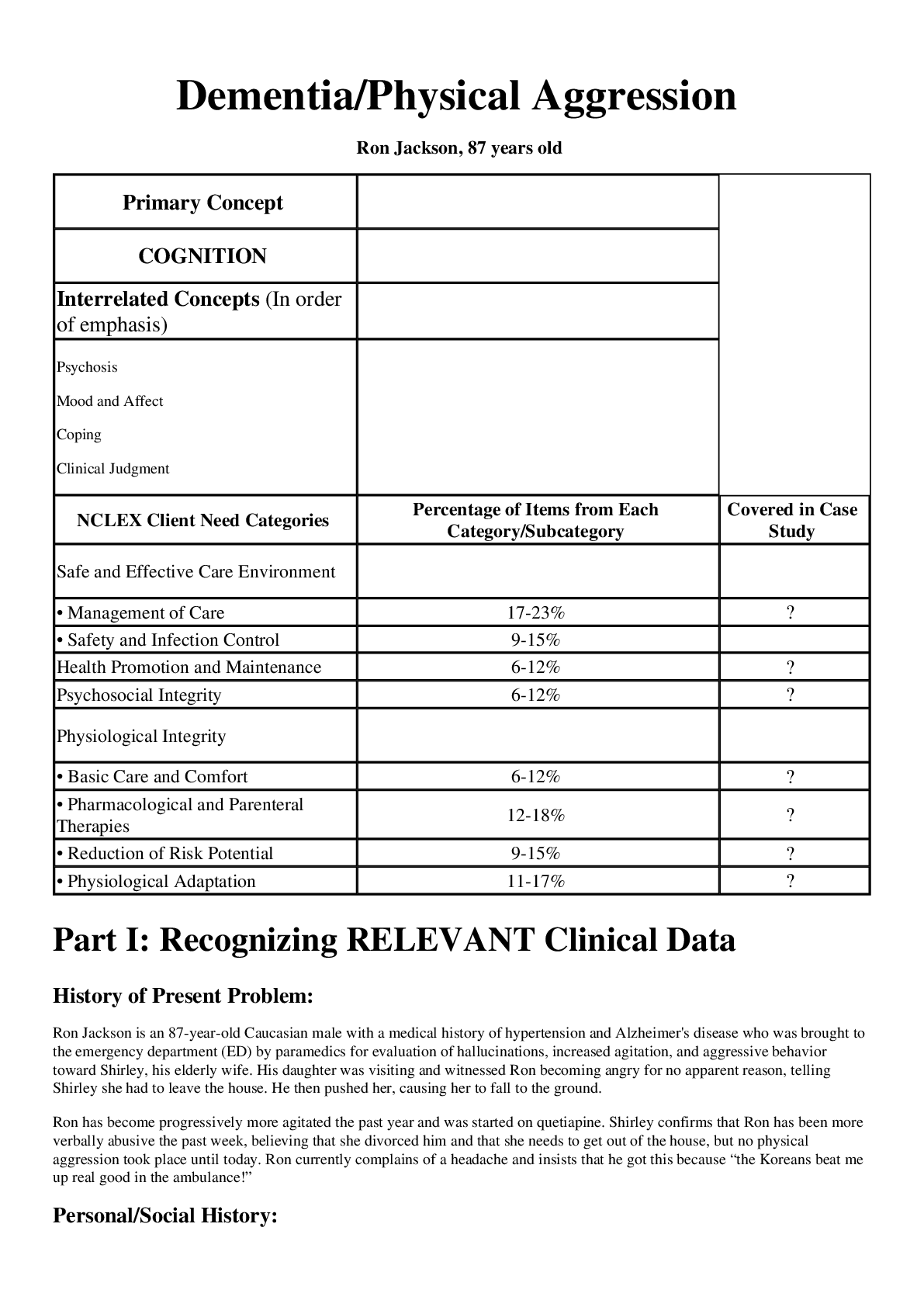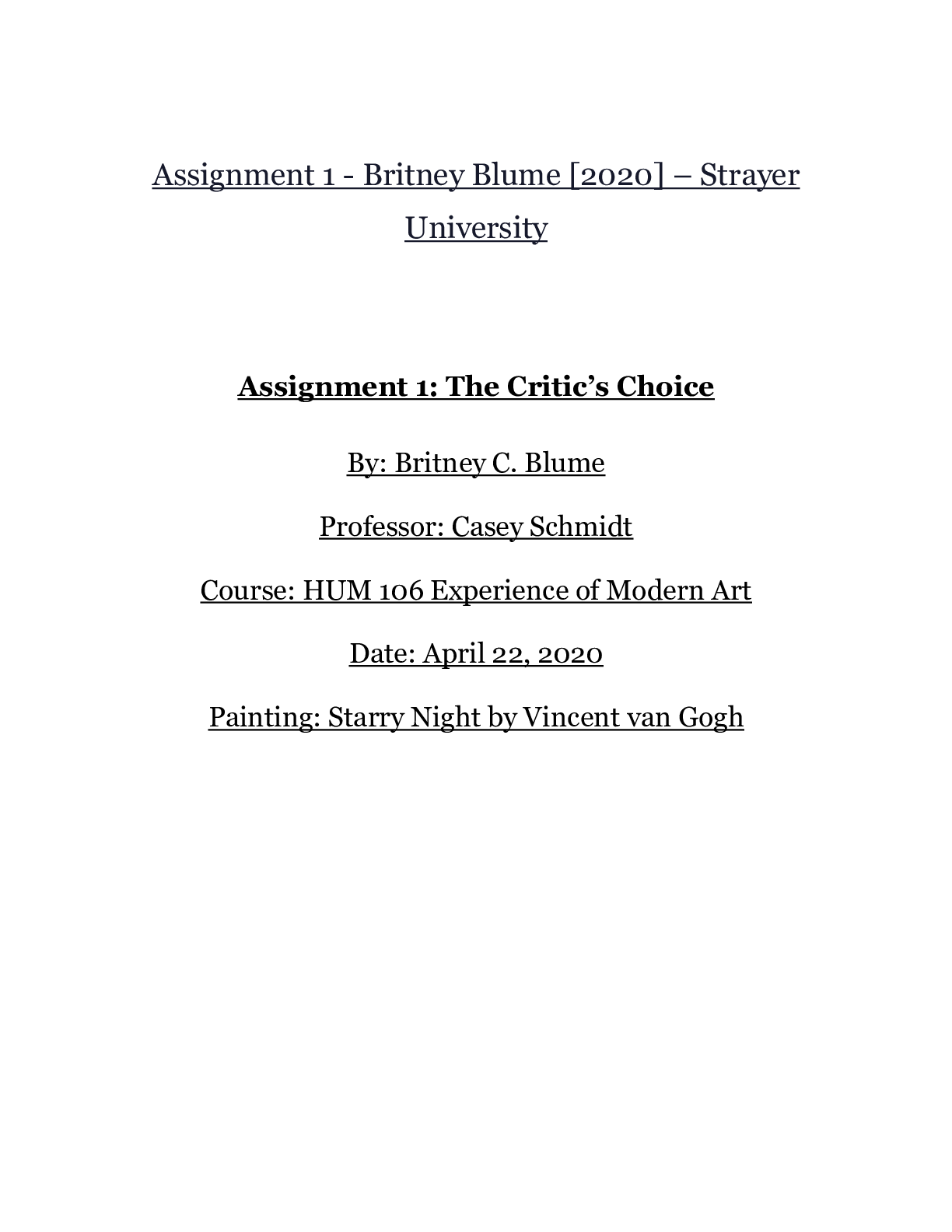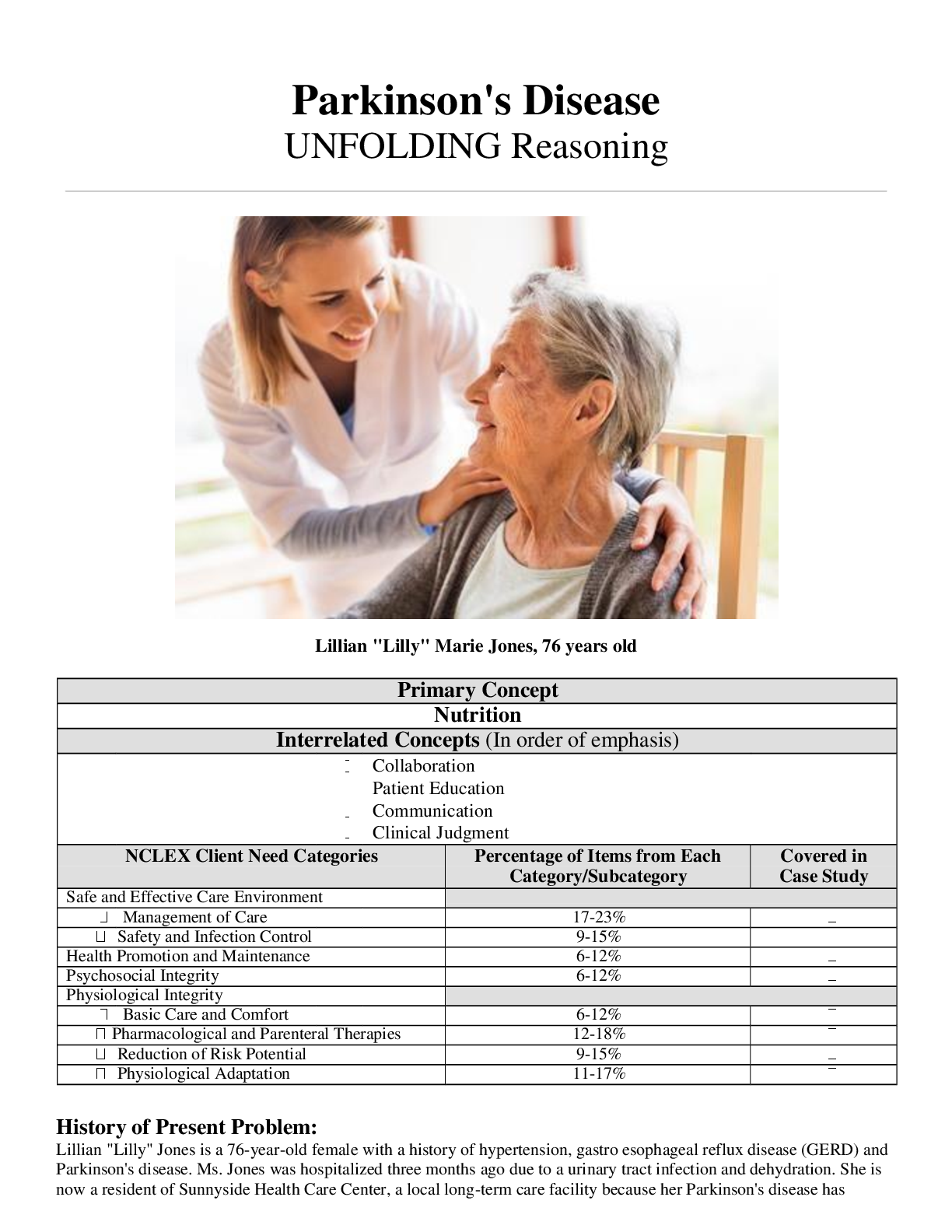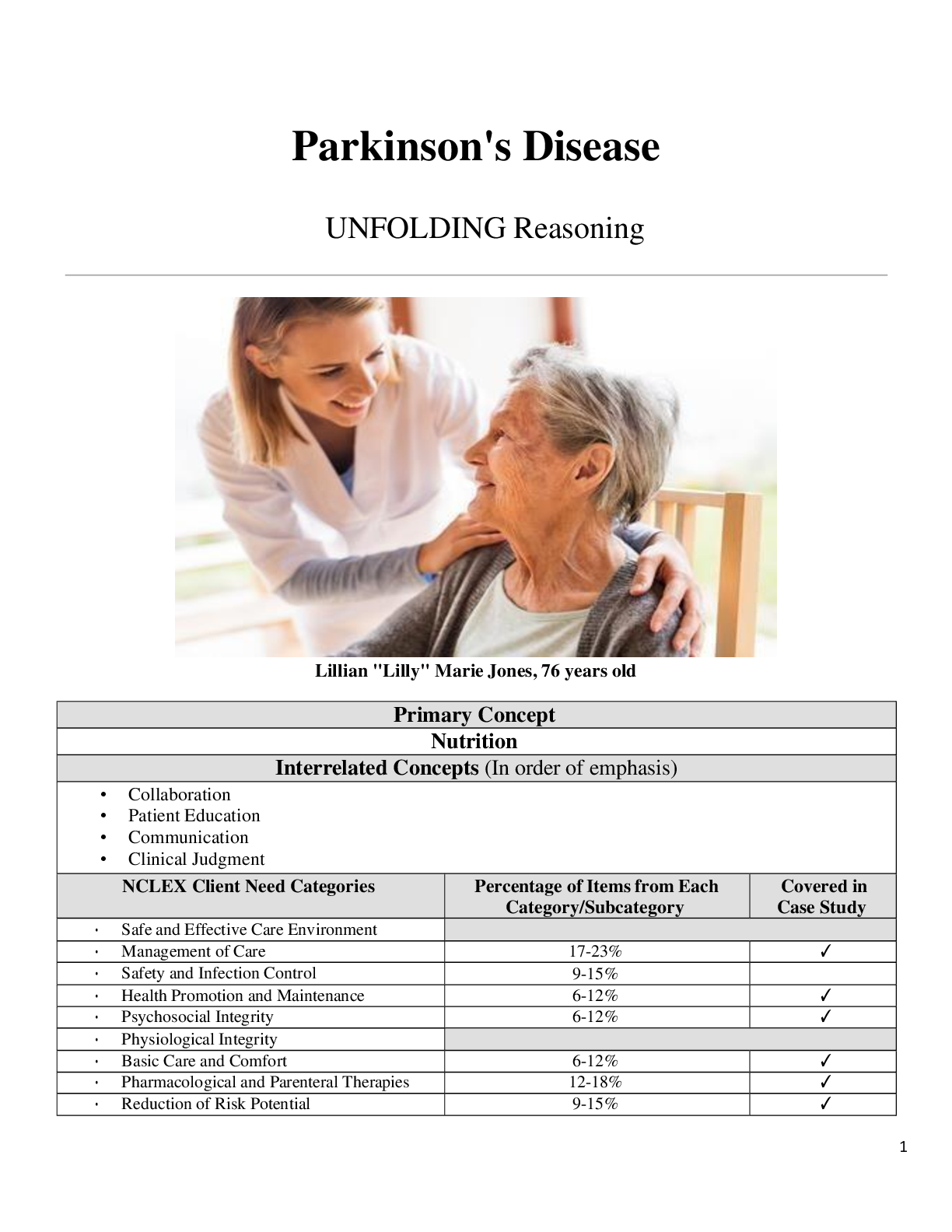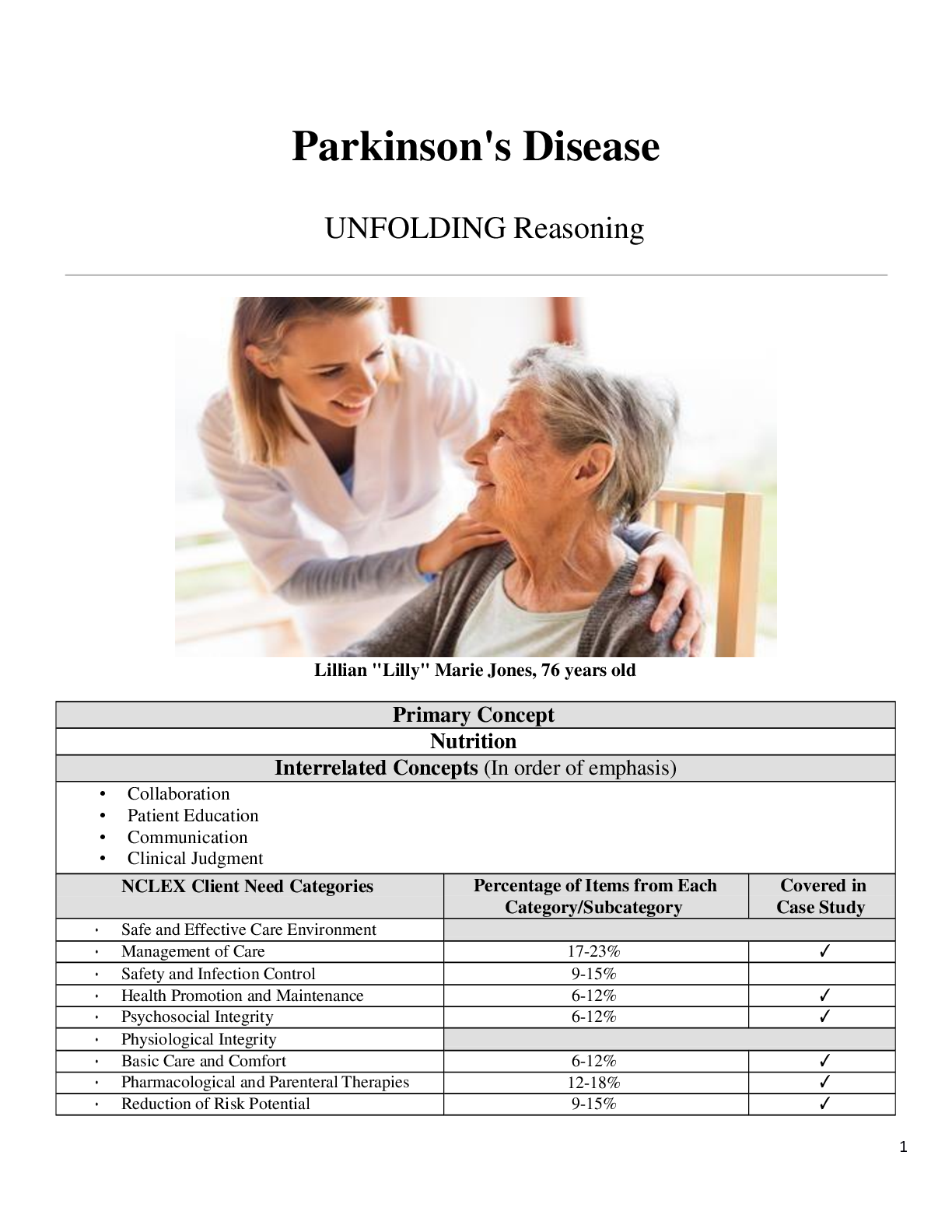*NURSING > CASE STUDY > Lillian "Lilly" Marie Jones _ Parkinson's Disease UNFOLDING Reasoning_2020 | Clinical_Parkinsons (All)
Lillian "Lilly" Marie Jones _ Parkinson's Disease UNFOLDING Reasoning_2020 | Clinical_Parkinsons
Document Content and Description Below
Parkinson's Disease UNFOLDING Reasoning Lillian "Lilly" Marie Jones, 76 years old Primary Concept Nutrition Interrelated Concepts (In order of emphasis) • Collaboration • Patient Ed... ucation • Communication • Clinical Judgment NCLEX Client Need Categories Percentage of Items from Each Category/Subcategory Covered in Case Study Safe and Effective Care Environment Management of Care 17-23% Safety and Infection Control 9-15% Health Promotion and Maintenance 6-12% Psychosocial Integrity 6-12% Physiological Integrity Basic Care and Comfort 6-12% Pharmacological and Parenteral Therapies 12-18% Reduction of Risk Potential 9-15% Physiological Adaptation 11-17% History of Present Problem: Lillian "Lilly" Jones is a 76-year-old female with a history of hypertension, gastro esophageal reflux disease (GERD) and Parkinson's disease. Ms. Jones was hospitalized three months ago due to a urinary tract infection and dehydration. She is now a resident of Sunnyside Health Care Center, a local long-term care facility because her Parkinson's disease has progressed and her son, Jack, is no longer able to care for her at home. Lilly has lost ten pounds (4.5 kg) in the past month. She is 5 feet-6 inches (167.6 cm) weighs 110 pounds (49.9 kg) and has a BMI of 17.8. After one week of residing at Sunnyside, Jack visits and is saddened when he finds his mother in her room alone. Jack approaches the nursing station and states, "My mother is so thin and losing weight and sits just staring into space. I thought having her here was going to help her get better!” Personal/Social History: Lilly was married to John for 54 years before he passed away two years ago. She has one son, Jack, who lives 30 minutes away. Jack has a medical power of attorney for Lilly's healthcare decisions. Lilly was a homemaker and an active participant in her community. Her hobbies include knitting, playing the piano and reading. Lilly reluctantly has agreed to go to Sunnyside Health Care Center after her son accepted a job that required him to travel. What data from the histories are RELEVANT and must be interpreted as clinically significant by the nurse? (Reduction of Risk Potential) RELEVANT Data from Present Problem: Clinical Significance: 76-year-old female Hx of hypertension, Hx of gastro esophageal reflux disease (GERD) Parkinson's disease Lost ten pounds in the last month, 5 fett-6inches weighs 110 lbs. and BMI of 17.8 Son found his mother in her room alone staring into space Physiological changes occur with aging in all organ systems. Hypertension increases the risk of heart disease, stroke, and other cardiovascular disease GERD is a highly prevalent disease caused by the exposure of the esophagus to refluxed gastric contents, PPIs are the mainstay of current treatment The cardinal symptoms of Parkinson's disease are shaking, stiffness, and slowness and poverty of movement. The condition leads to physical signs including tremor at rest, rigidity on passive movement, slowness of movement (bradykinesia), and poverty of movement (hypokinesia). In patients with low body weight, the brain becomes starved and they can develop symptoms that meet the criteria for depression. A BMI of 20-25 is ideal; 25-30 is overweight and over 30 is obese. If the patient’s BMI is under 18.5, they considered underweight Chronic loneliness can have a significant impact on the overall health, including the mental health of the patient. Loneliness can increase the patient’s risk for depression RELEVANT Data from Social History: Clinical Significance: Husband, John, passed away two years ago Medical power of attorney, the son Jack, lives 30 minutes away Was a homemaker, an active participant in her community, and had many hobbies. She reluctantly agreed to go to Sunnyside Health Care Center after her son accepted a job that required him to travel. Coping with the death of a significant other isn’t easy. Grief can affect our body, mind, emotions, and spirit. A medical power of attorney is a legal document that names one person the health care agent of another person. The agent has the ability to make health care decisions and the responsibility to make sure doctors and other medical personnel provide necessary and appropriate care according to the patient's wishes. Due to the son living 30 mins away and at a new job it may be harder to get a hold of him or take longer for him to get to the facility to make medical decisions for his mother. Knowing this can help show just how differently Lilly is acting now that she is at Sunnyside Health Care Center. These changes in her behavior can be a sign of depression. Patient Care Begins: Current VS: P-Q-R-S-T Pain Assessment: T: 98.4 F/36.9 C (oral) Provoking/Palliative: "Better when walking a while." P: 90 (regular) Quality: "ache" R: 14 (regular) Region/Radiation: "Knees" BP: 112/70 Severity: "3/10" O2 sat: 98% room air Timing: "When I wake up." What VS data are RELEVANT and must be interpreted as clinically significant by the nurse? (Reduction of Risk Potential/Health Promotion and Maintenance) RELEVANT VS Data: Clinical Significance: Pain: aching knee pain 3/10 after waking, better when walking a while Pain is part of the body's defense system, producing a reflexive retraction from the painful stimulus, and tendencies to protect the affected body part while it heals, and avoid that harmful situation in the future. Joint pain is common with aging and can be difficult to differentiate from conditions like Arthritis and Parkinson's. Current Assessment: GENERAL SURVEY: Alert, flat affect and slow to respond to questions in a soft tone (hypophonia). Oriented and in no acute distress, dress appropriate for the season, hygiene and grooming normal for age and gender. Sitting with a forward leaning posture. NEUROLOGICAL: Alert & oriented to person, place, time, and situation (x4); muscle strength 4/5 in both upper and lower extremities bilaterally. Tremors noted at rest in hands. HEENT: Head normocephalic with the symmetry of all facial features, but tremor noted. PERRLA, sclera white bilaterally, conjunctival sac pink bilaterally. Lips, tongue, and oral mucosa pink and tacky dry. RESPIRATORY: Breath sounds clear with equal aeration on inspiration and expiration in all lobes anteriorly, posteriorly, and laterally, nonlabored respiratory effort on room air. CARDIAC: Pink, warm & dry, no edema, heart sounds regular, pulses strong, equal with palpation at radial/pedal/post-tibial landmarks, brisk cap refill. Heart tones audible and regular, S1 and S2, noted over A-P-E-T-M cardiac landmarks with no abnormal beats or murmurs. No JVD noted at 30-45 degrees. ABDOMEN: Abdomen round, soft, and nontender. BS hypoactive in all four quadrants. GU: Urinary Incontinent episode x1, urine yellow INTEGUMENTARY: Skin oily but warm with normal color for ethnicity. No clubbing of nails, cap refill <3 seconds, Hair soft, distribution normal for age and gender. Skin integrity intact, skin turgor elastic, tenting present. What assessment data is RELEVANT and must be interpreted as clinically significant by the nurse? (Reduction of Risk Potential/Health Promotion & Maintenance) RELEVANT Assessment Data: Clinical Significance: General: Alert, flat affect and slow to respond to questions. Sitting with a forward leaning posture. Neuro: Tremors noted at rest in hands. HEENT: tremor noted. Lips, tongue, and oral mucosa pink and tacky dry. Abdomen: BS hypoactive in all four quadrants. GU: Urinary Incontinent episode x1, urine yellow Integumentary: tenting present The patient’s slow response to questions and postural instability can be a clinical manifestation of her Parkinson Disease. Flat affect is a severe reduction in emotional expressiveness which can be a sign of depression, which can also be a nonmotor clinical manifestation of her Parkinson Disease The patient’s tremor is most likely a motor clinical manifestation of her Parkinson Disease The patient s lips, tongue, and oral mucosa is tacky dry. This can be caused by not drinking enough fluids, sleeping with mouth open, dry hot weather, eating dry foods, or medication side effects. Hypoactive, or reduced, bowel sounds often indicate that intestinal activity has slowed down. Hypoactive bowel sounds are normal during sleep, after the use of certain medicines, and after abdominal surgery. Decreased or absent bowel sounds often indicate constipation. The patient has had an incontinent episode, if this happens more often it will place the patient at a higher risk for skin breakdown and impaired skin integrity Tenting of the skin can indicate severe dehydration that needs quick treatment. The patient may have reduced skin turgor and may unable to increase their intake of fluids due to nausea and vomiting Lab Results-On Admission: Complete Blood Count (CBC) WBC HGB PLTs % Neuts Bands Current: 8.5 10.8 154 65 0 Last Month: 6.4 12.8 208 55 0 What lab results are RELEVANT and must be recognized as clinically significant by the nurse? (Reduction of Risk Potential/Physiologic Adaptation) RELEVANT Lab(s): Clinical Significance: TREND: Improve/Worsening/Stable: WBC: 8.5 Hgb: 10.8 PLTs: 154 Neuts: 65% Bands: 0 Always relevant based on its correlation to the presence of inflammation or infection. Will usually be increased if infection is present, though it may be decreased in the elderly or peds <3 months ALWAYS RELEVANT to determine anemia or acute/chronic blood loss. Relevant whenever there is a concern for anemia or blood loss, or if a patient is on heparin. If platelets are low, it will obviously be significant and must be noted. Any patient on heparin products must also have this noted because of the clinical possibility of heparin-induced thrombocytopenia (HIT), which develops when the immune system forms antibodies against heparin and causes small clots and lower platelet levels. ALWAYS RELEVANT for same reason as WBCs. They are the most common leukocyte and their role is as a FIRST RESPONDER to any bacterial infection within several hours or when the inflammatory response is activated. Essential for fighting disease – low count puts the patient at an increased risk for infections-- might be tied to patient’s anemia or breast cancer Stable Worsening Stable, but going down, keep a close eye on this Stable Stable, but low Basic Metabolic Panel (BMP) Na K Gluc. Creat. BUN Current: 142 3.7 88 1.4 38 Last Month: 135 3.4 90 1.0 22 What lab results are RELEVANT and must be recognized as clinically significant by the nurse? (Reduction of Risk Potential/Physiologic Adaptation) RELEVANT Lab(s): Clinical Significance: TREND: Improve/Worsening/Stable: Na: 142 K: 3.7 Gluc.: 88 Creat.: 1.4 BUN: 38 It helps maintain normal blood pressure, supports the work of nerves and muscles, and regulates fluid balance. If your sodium blood levels are too high or too low, it may mean that there is problem with the kidneys, dehydration, or another medical condition. ALWAYS relevant and must be noted by the nurse even though normal. Essential to normal cardiac electrical conduction, as is Mg+. If too high or low, it can predispose to rhythm changes that can be life threatening High-Normal Fasting Blood Sugar Above 87 mg/dL Could Signal Diabetes Risk. Men and women with fasting plasma glucose levels in the high-normal range of 87 to 99 mg/dL should be counseled with regard to weight and lifestyle, and assessing their lipid profiles GOLD STANDARD for kidney function and adequacy of renal perfusion. The functioning of the renal system impacts every body system; therefore, it is ALWAYS relevant. The creatinine is slightly elevated and the nurse needs to note the last level and trend. The patient may have chronic renal insufficiency secondary to diabetes and HTN. This is not an imminent concern, but the nurse will need to closely monitor and assess urine output High BUN can mean a kidney injury or disease is present --- Can also be caused by low blood flow to the kidneys caused by dehydration or heart failure Stable Stable Stable Worsening Worsening - - - Continued [Show More]
Last updated: 2 years ago
Preview 1 out of 25 pages
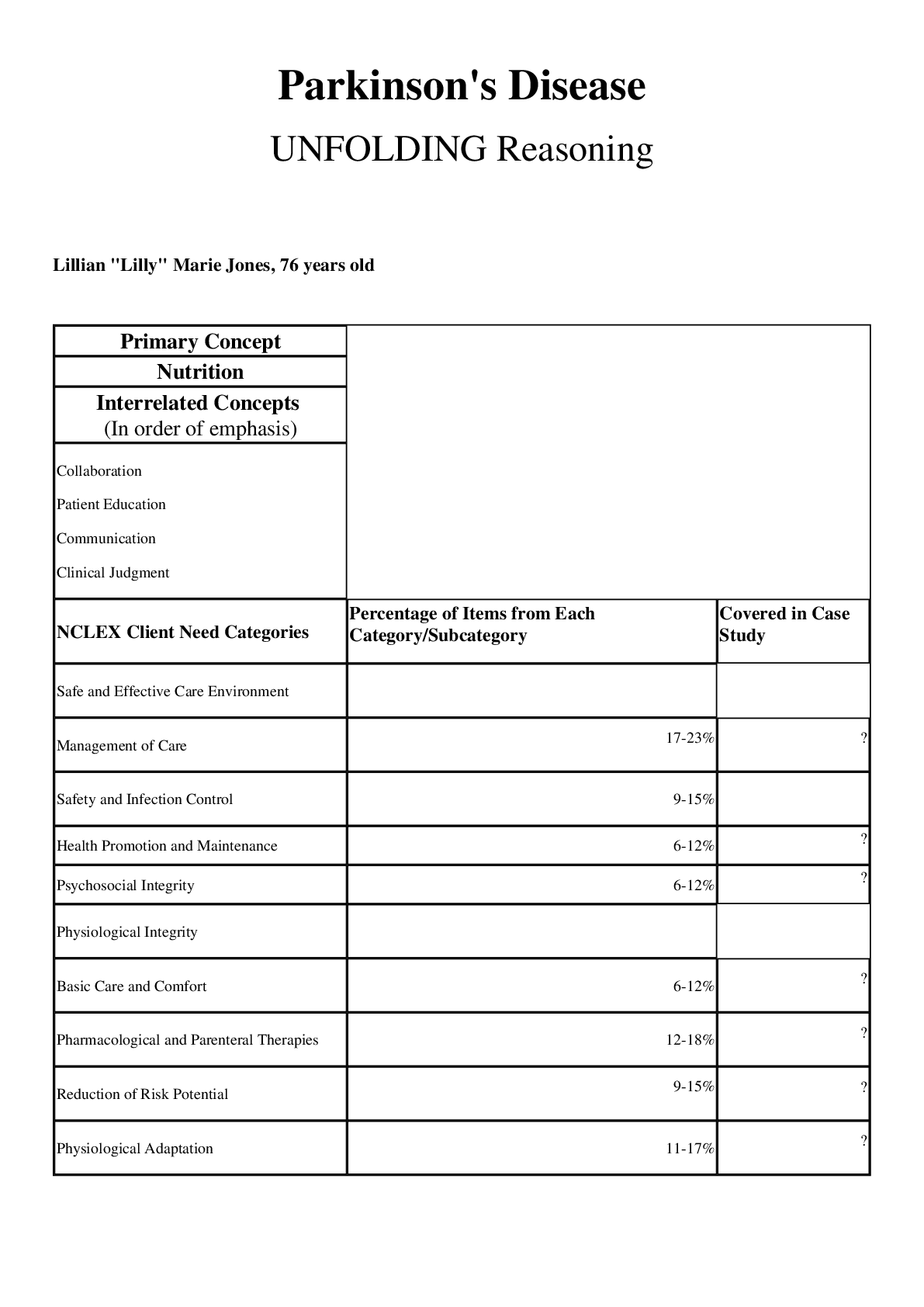
Buy this document to get the full access instantly
Instant Download Access after purchase
Buy NowInstant download
We Accept:

Reviews( 0 )
$12.50
Can't find what you want? Try our AI powered Search
Document information
Connected school, study & course
About the document
Uploaded On
Feb 28, 2021
Number of pages
25
Written in
Additional information
This document has been written for:
Uploaded
Feb 28, 2021
Downloads
0
Views
132




